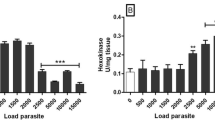Abstract
The activity of glutamate-pyruvate transaminase (GPT) increases regularly as the fourth instar larva of Zabrotes subfasciatus develops into prepupa. On the other hand, glutamate-oxaloacetate transaminase (GOT) activity increases significantly (P < 0.05) during the first 12 hr, and then remains at a sufficiently constant level during the subsequent development of this larval instar except at 36 hr of development. However, at the time of prepupation, the GOT and GPT-activities show a decline, which is subsequently followed by an increase during the rest of the prepupal development. The activity of GOT is quite high during the early pupal life, i.e. up to 120 hr. On the other hand, GPT-activity falls significantly (P < 0.05) during the first 24 hr of pupal life and rise up to 120 hr during pupal development. Once again, in the late pupal development, the transaminases remain very active on account of the faster rate of histogenesis. During early adult life, the GOT and GPT are still active, as the early part of adult life of the insect is physiologically quite vigorous and accordingly the energy requirements of the body at this stage are intense. Subsequently, there occurs a regular attenuation of the activities of both of the transaminases in the aging bruchid.
Résumé
L’activité des glutamate-pyruvate transaminase (GPT) augment régulièrement à measure que la quatrième instar larva de Zabrotes subfasciatus développe en prépupa. Au contraire, l’activité du glutamate-oxaloacetate transaminase (GOT) augmente significativement pendant les premières 12 hr et ensuite reste a un inveau suffisament constant pendant le dévelopment du instar larva qui suive, sauf à la 36e hr du dévelopment. Pourtant au moment de la prépupation, les activités des GOT et GPT montrent une dimunition qui est ensuite suivi d’une augmentation pendant le reste due dévelopment prépupa. L’activité de GOT est assez élevé pendant le début de l’âge pupal, l’est à dire jusqu’à la 120e hr. Au contraire, l’activité GPT décroît significativement (P < 0.05) pendant les premières 24 hr de la vie pupale qui pourtant continue à augmente jusqu’à la 120e hr du développment pupale. Encore, pendant le développement pupal tardif les transaminases restent très actifs à cause ce cadence plus rapide de histogenesis. Pendant le commencement de l’âge adulte, le GOT et le GPT sont encore actifs, puis que la première partie de la vie adulte de l’insecte est assez vigoureuse et en conséquence les besoins de l’energie du corps en ce moment sont intenses. Ensuite, il se produit une atténuation régulière des activités des deux transaminases dans les bruchids vieillissants.
Similar content being viewed by others
References
Arora G. L. (1977) Taxonomy of the bruchids (Coleóptera) of North-West India. Orient. Insects 7, 92.
Ashmore J., Wagle S. P. and Uete T. (1964) Studies on gluconeogenesis. In Advances in Enzyme Regulation (Edited by Weber G.), Vol. 2, pp. 101–114. Pergamon Press, Oxford.
Bergner H., Muenchow H. and Wirthgen S. (1968) Correlation between protein nutrition, thyroid secretion rate, and the activities of certain enzymes. Acta biol. med. germ. 21, 683–686.
Chang Y. Y. H., Frazier J. L. and Heitz J. R. (1979) Time course of enzyme development in the boll weevil, Anthonomus grandis. Comp. Biochem. Physiol. 62B, 45–50.
Chen P. S. (1966) Amino acid and protein metabolism in insect development. In Advances in Insect Physiology, Vol. 3, pp. 53–132. Academic Press, New York.
Cohen P. P. (1951) In The Enzyme (Edited by Summer J. B. and Myrback K.), Vol. I, Chap. 2, pp. 1040–1067. Academic Press, New York.
Gilbert L. I. (1967) Lipid metabolism and function of insects. Adv. Insect Physiol. 4, 69–211.
Kaur S. P. (1984) Studies on the biochemical changes related to the metamorphosis and adult life of Zabrotes subfasciatus (Boh.) (Coleóptera: Bruchidae). Ph.D. thesis, Punjabi University, Patiala.
Knox W. E. and Greengard O. (1965) The regulation of some enzymes of nitrogen metabolism—an introduction to enzyme physiology. In Advances in Enzyme Regulation (Edited by Weber G.), Vol. 3, pp. 247–313. Pergamon Press, Oxford.
Lowry O. H., Rosebrough N. J., Farr A. L. and Randall R. J. (1951) Protein measurement with the folin phenol reagent. J. biol. Chem. 193, 265–275.
Mordue W. and Goldsworthy G. J. (1973) Transaminase levels and uric acid production in adult locusts. Insect Biochem. 3, 419–427.
Nimni M. E., Horn D. and Barette L. A. (1962) Dietary composition and tissue protein synthesis. II. Tryptophan toxicity and amino acid deficiency in collagen synthesis. J. Nutr. 78, 133–138.
Nohel P. and Slama K. (1972) Effect of juvenile hormone analogue on glutamate-pyruvate transaminase activity in the bug, Pyrrhocoris aplerus. Insect Biochem. 2, 58–66.
Pant R. and Morris I. D. (1972) A comparative study on the variation of aminotransferase activity and its total free amino acids in the fat body, haemolymph and intestine and haemolymph protein content in Philosamia ricini during larval-pupal development. Indian J. Biochem. Biophys. 9, 199–202.
Pant R. and Kumar S. (1980) Significance of some enzymes and metabolites during aging of the dipteran fleshfly, Sarcophaga ruficornis. Curr. Sci. 49, 10–13.
Pant R. and Pandey K. N. (1980) Variations in different biochemical parameters in the fat body of Antheraea mylitta (Tasar silkworm). Indian J. exp. Biol. 18, 537–539.
Reitman S. and Frankel S. (1957) A colorimetrie method for the determination of serum glutamic oxaloacetic acid and glutamic pyruvic transaminases. Am. J. clin. Path. 28, 56–63.
Sidhu D. S. (1982) Biochemical investigations on the post-embryonic development of Chilomenes sexmaculata Fabr. (Coleóptera: Coccinellidae). Ph.D. thesis, Punjabi University, Patiala.
Wergedal J. E., Ku Y. and Harper A. E. (1964) Influence of protein intake on the catabolism of ammonia and glycine in vivo. In Advances in Enzyme Regulation (Edited by Weber G.), Vol. 2, pp. 289–310. Pergamon Press, Oxford.
Author information
Authors and Affiliations
Rights and permissions
About this article
Cite this article
Kaur, S.P., Sidhu, D.S., Dhillon, S.S. et al. Transaminases During Development and Aging of the Bruchid, Zabrotes Subfasciatus (Boh.) (Coleoptera: Bruchidae). Int J Trop Insect Sci 6, 585–590 (1985). https://doi.org/10.1017/S1742758400009140
Received:
Revised:
Published:
Issue Date:
DOI: https://doi.org/10.1017/S1742758400009140




